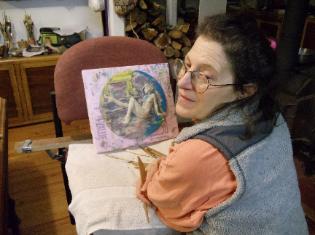Wendy Saxon Brown
The human figure, if done well, speaks to the viewer in a personal way. The figurative sculpture mirrors our habits, our thoughts, our flaws, our aspirations, and us. It is a symbol of us and therefore the perfect vehicle of communication for me. I love sculpting the anatomy into shapes that are exciting and full of movement and emotion. There are endless possibilities and always challenges. I love drawing from life; in fact, I hire models several times a week for both drawing and sculpture. The drawings are usually incorporated into designs that will be cast in glass. The challenge of creating a relief in glass should not be underestimated. It is necessary to sandwich a 3-D object into a nonexistent space that hovers someplace between a flat 2-D image and something not quite 3-D. There are unlimited possibilities within this range – from an extremely flat low relief, such as the image on a dime, to the nearly full-sculpted figure in my pate de verre pieces. There are no rules or formulas to assist the artist in the squashing of three dimensions. The artist creates an illusion of 3 dimensions, while employing only some portion of that dimension. The only rule I follow is that, in the end, the relief must be both believable and beautiful. The pate de verre are the most challenging pieces of my career to date. The aggressive use of color along with the huge variety of depth and form pushes the nature of glass to new possibilities. The casting process is “Pate de Verre” – due to the combining of glass particles (frit) to create the wide palette of colors in these pieces. The reliefs achieve multiple colors by placing colored glass frit in to each area, the density of color is determined by its thickness and the other colors that surround or are layered on top. Some are blended and others have a pointillist effect. The reverse reliefs have the sculpture impressed in the back with clear glass melted on top. The colored frit is in the bottom layer; the overall appearance is that the relief is captured inside the glass. The shapes and forms of the sculpture are modeled with reflective light so that they naturally change with the direction and color of the light source. Because the reliefs and reverse reliefs are so deep, they naturally produce dramatic highlights and shadows. The 3D sculptures are cast using the lost wax method which is similar to bronze casting, except the glass is melted into the mold in the kiln, and annealed for many weeks. To achieve multiple colors in this work requires the arduous task of cutting up the wax so that they can be cast separately, and then fitting and reassembling them afterwards. Light affects glass in many dramatic and unexpected ways. Notice how a backlit head will light the face, or how bubbles create dimension.


